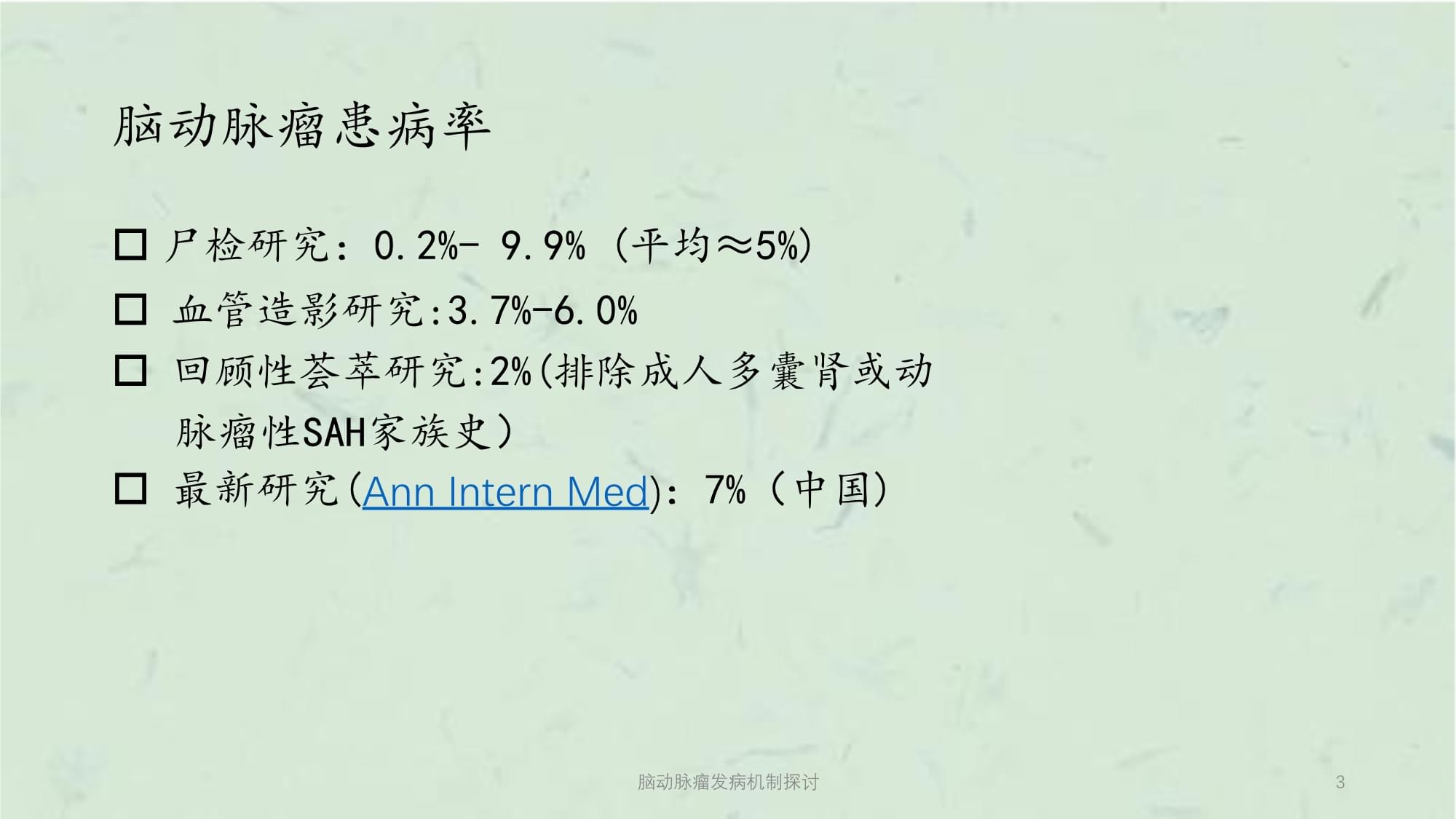




版权说明:本文档由用户提供并上传,收益归属内容提供方,若内容存在侵权,请进行举报或认领
文档简介
1、脑动脉瘤发病机制探讨谭华桥 MD PhD上海. 2013.12脑动脉瘤发病机制探讨1脑动脉瘤发病机制探讨谭华桥 MD PhD上海. 2013.脑动脉瘤定义A brain aneurysm is a protruding bubble or sac on a blood vessel caused by a weak spot in the vessel wall that balloons out over time. 脑动脉瘤发病机制探讨2脑动脉瘤定义A brain aneurysm is a pr脑动脉瘤患病率 尸检研究:0.2%- 9.9% (平均5%) 血管造影研究:3.7%-6.0%
2、 回顾性荟萃研究:2%(排除成人多囊肾或动 脉瘤性SAH家族史) 最新研究(Ann Intern Med):7%(中国) 脑动脉瘤发病机制探讨3脑动脉瘤患病率 尸检研究:0.2%- 9.9% (平均5%动脉瘤性SAH发病率和危害性 动脉瘤性SAH发病率WHO研究发现欧洲和亚洲国家校正年龄年动脉瘤性SAH发病率相差10倍(中国2/100000;芬兰22.5/100000)最新的荟萃研究:动脉瘤性SAH发病率2-16/100000动脉瘤性SAH危害性 10-15%患者在入院接受治疗前死亡 致死率高达40%50%,致残率高达10%20% 脑动脉瘤发病机制探讨4动脉瘤性SAH发病率和危害性 动脉瘤性S
3、AH发病率动脉瘤性S动脉瘤好发部位脑动脉瘤发病机制探讨5动脉瘤好发部位脑动脉瘤发病机制探讨5脑动脉瘤病理内弹力板缺乏,中膜平滑肌细胞凋亡减少,中膜变薄甚至连续性中断 . a=外膜 m=中膜, i =内膜,eel=外弹力板 Iel=内弹力板脑动脉瘤发病机制探讨6脑动脉瘤病理内弹力板缺乏,中膜平滑肌细胞凋亡减少,中膜变薄甚脑动脉瘤病理变化过程内皮功能紊乱血管平滑肌细胞(VSMC)表型转化细胞外基质(ECM)重塑VSMC凋亡、血管退变 VSMC凋亡、血管退变 局限性扩张动脉瘤形成生长、破裂脑动脉瘤发病机制探讨7脑动脉瘤病理变化过程内皮功能紊乱血管平滑肌细胞(VSMC)表脑动脉瘤发病因素先天性或遗传性
4、因素脑血管解剖变异先天性中膜缺损 遗传基因差异家族性颅内动脉瘤后天性获得因素血流动力学环境因素,如吸烟、饮酒、高血压、高脂血症、雌激素、感染、创伤等 脑动脉瘤发病机制探讨8脑动脉瘤发病因素先天性或遗传性因素后天性获得因素脑动脉瘤发病脑动脉瘤发生-先天性或遗传性因素脑血管解剖变异Willis 环及脑动脉系统常见的解剖形态学异常 双侧脑动脉直径的显著差异 某些脑动脉节段先天性缺如或发育不全 某些胚胎发育过程中的原始动脉通道( 如残存的三叉动脉、舌下动脉等) 残留 某些先天性脑血管疾病,如: MOYAMOYA病、AVM 等脑动脉瘤发病机制探讨9脑动脉瘤发生-先天性或遗传性因素脑血管解剖变异脑动脉瘤发
5、病机脑动脉瘤发生- 先天性或遗传性因素先天性中膜缺陷理论基础: 脑主要动脉的分支部位动脉壁存在中膜缺陷,而动脉分叉是颅内动脉瘤的好发部位.理论缺陷:约80%的脑血管分叉部均存在中膜缺损, 而动脉瘤的发病率却远远低于这一水平. 动脉瘤瘤壁组织中中膜结构的损伤可能并非动脉瘤形成时的始动因素, 而是动脉瘤发生、发展的结果 脑动脉瘤发病机制探讨10脑动脉瘤发生- 先天性或遗传性因素先天性中膜缺陷脑动脉瘤发病脑动脉瘤发生-先天性或遗传性因素遗传基因证据常染色体显性遗传多囊肾疾病(ADPKD) 神经纤维瘤病I型 马凡氏综合症 多发性内分泌瘤病 I型弹性假黄色瘤 遗传性出血性毛细血管扩张症埃当综合征 II
6、和 IV型相关候选基因与细胞外基质成分合成相关的基因:ELN(弹性蛋白)、COL(胶原蛋白)3A1、COL1A2、LOX、FBN2与细胞外基质降解相关的多种蛋白酶编码基因: MMPs、TIMPs、A1 antitrypsin COL1A2和ELN是最有可能与颅内动脉瘤等位遗传基因相关的候选基因。遗传性因素脑动脉瘤发病机制探讨11脑动脉瘤发生-先天性或遗传性因素遗传基因证据相关候选基因遗传血流动力学因素在脑动脉瘤发生中发挥重要作用脑动脉瘤发生-后天获得性因素 脑动脉瘤发病机制探讨12血流动力学因素在脑动脉瘤发生中发挥重要作用脑动脉瘤发生-后天Stroke. 2002;33:1911-1915方法
7、:结扎双侧肾后动脉诱发肾性高血压+结扎单侧颈总动脉增加对侧ACA-OA血流结果:增加的血流动力学应力和诱导高血压能够诱发大鼠实验性脑动脉瘤形成脑动脉瘤发病机制探讨13Stroke. 2002;33:1911-1915方法:结扎内弹力板破坏和高血压能够诱发大鼠颅内动脉瘤形成,两者在颅内动脉瘤形成中具有协同效应Hypertension. 2009;54:1337-1344 脑动脉瘤发病机制探讨14内弹力板破坏和高血压能够诱发大鼠颅内动脉瘤形成,两者在颅内动Stroke. 2008;39:2085-2090单独增加血流动力学损伤能够诱发新生脑动脉瘤,这种新生动脉瘤破坏性重塑依赖于增加的血流脑动脉瘤发
8、病机制探讨15Stroke. 2008;39:2085-2090单独增加血Stroke. 2007;38:1924-1931 高的壁切应力和切应力梯度易于导致顶端动脉瘤形成脑动脉瘤发病机制探讨16Stroke. 2007;38:1924-1931 高的壁切高的壁切应力和正性切应力梯度是诱发动脉瘤样重塑的危险血流动力学 Stroke. 2010;41:1774-1782脑动脉瘤发病机制探讨17高的壁切应力和正性切应力梯度是诱发动脉瘤样重塑的危险血流动力Neurosurgery 65:169178, 2009脑动脉瘤发病机制探讨18Neurosurgery 65:169178, 2009脑.bFG
9、F =basic fibroblast growth factor; COX2=cyclooxygenase-2; ECM=extracellular matrix; ICAM=intercellular adhesion molecule; IL= interleukin; MCP=monocyte chemoattractant Protein MMP=matrix metalloproteinase; NK= natural killer; NO=nitric oxide; PGD= prostaglandin D; PGE= prostaglandin E;ROS= reactive
10、oxygen species; TGF=transforming growth factor; TLR= toll-like receptor; TNF=tumor necrosis factor; VCAM=vascular cell adhesion moleculeVEGF= vascular endothelial growth factor VSMC=vascular smooth muscle cell Cerebral aneurysm (CA) formation and rupture.Stroke. 2013;44:3613-3622.脑动脉瘤发病机制探讨19.Cerebr
11、al aneurysm (CA) formatPathwayMediatorsPathwayMediatorsEndothelial dysfunctionIL-1NF-BEts-1MCP-1Reactive oxygen speciesNitric oxide (NO), endothelial NO synthase, inducible NO synthaseAngiotensin IIPhosphodiesterase-4Prostaglandin E2E selectin, P selectin, vascular cell adhesion protein 1 (VCAM1), I
12、ntercellular adhesion molecule 1 (ICAM1)Macrophages, M1/M2 imbalance, leukocyte infiltrationMCP-1IL-17IL-8EotaxinTNF-IL-1MMPsEts-1NF-BNormal T cell expressed and secretedMonokine induced by -interferonInterferon-induced protein-10Inflammatory Pathways and Mediators Implicated in CA Formation and Rup
13、tureStroke. 2013;44:3613-3622.脑动脉瘤发病机制探讨20PathwayMediatorsPathwayMediatoPathwayMediatorsPathwayMediatorsPhenotypic modulation andloss of SMCsTNF-Adhesion moleculesMMPsMCP-1P47phoxIL-1KLF-4Vascular remodeling, Cell deathMMP and cathepsinsTNFIL-1, IL-6Toll-like receptor 4FasNOComplement IgG, IgMBasic
14、fibroblast growth factorTransforming growth factor and Vascular endothelial growth factorReactive oxygen speciesInflammatory Pathways and Mediators Implicated in CA Formation and RuptureStroke. 2013;44:3613-3622.IL-1 indicates interleukin 1; KLF-4, Kruppel-like transcription factor 4; MCP-1, monocyt
15、e chemoattractant protein-1; MMP, matrix metalloproteinase;NF-B, nuclear factor- B; SMC, smooth muscle cell; and TNF, tumornecrosis factor-.脑动脉瘤发病机制探讨21PathwayMediatorsPathwayMediatoC, complement system; C3a and C5a, anaphylatoxins; CRP, C reactive protein; EC, endothelial cell; IFN-g, interferon ga
16、mma; IgG, immunoglobulin G; IgM, immunoglobulin M; IL-1b, interleukin 1-beta; M, macrophage; MCP-1, monocyte chemotactic protein; MHC-I and MHC-II, major histocompability complexes I and I; MMP, matrix metalloproteinase; NK, natural killer cell; RNS, reactive nitrogen species; ROS, reactive oxygen s
17、pecies; SCR, scavenger receptor; SMC, smooth muscle cell; T, T cell; TGF-b, tissue growth factor beta; TNF-a, tumor necrosis factor-alpha; VCAM-1, vascular cell adhesion molecule-1.Probable activators and main functions of macrophages in intracranial aneurysms.脑动脉瘤发病机制探讨22C, complement system; C3a a
18、nd probable activation mechanisms and functions of adaptive immunity in intracranial aneurysms巨噬细胞或其他抗原呈递细胞抗原组织相容性抗原复合物组织相容性抗原复合物Cytokines and inflammatory mediators Interferon gamma, IFN-g; Tumor necrosis factor alpha and beta, TNF-a and TNF-b; Interleukins, ILMHC= major histocompability complexTCR
19、 =T cell receptor M = macrophage T cell recognizes the Th =CD4 (helper T cells,) Tc = CD8 (cytotoxic T cells) NK =Natural killer脑动脉瘤发病机制探讨23probable activation mechanismsJournal of Cerebral Blood Flow & Metabolism (2012) 32, 16591676Vascular smooth muscle cells (VSMCs) in intracranial aneurysm (IA)
20、wall. Phenotypic modulation of VSMC from a contractile to pro-inflammatory/pro-matrix remodeling phenotype within the aneurysm wall leads to myointimal hyperplasia, inflammation, and vessel wall degeneration. Subsequent apoptosis and VSMC death lead to a hypocellular thin wall with increased IA susc
21、eptibility to rupture. SM-MHC, smooth muscle-myosin heavy chain; SM-actin, smooth muscle-actin; SSAO, semicarbazide-sensitive amine oxidase; NO, nitric oxide; TNF, tumor necrosis factor-; MCP1, monocyte chemoattractant protein 1; IL1, Interleukin 1; ROS, reactive oxygen species; MMPs, matrix metallo
22、proteinases.脑动脉瘤发病机制探讨24Journal of Cerebral Blood FlowStroke. 2009;40:942-951MCP-1在动脉瘤形成早期阶段表达上调, MCP-1基因敲出的大鼠动脉瘤形成下降、巨噬细胞聚集下降,MMP-2和MMP-9、iNOS表达下降,在MCP-1表达的细胞中显示NF- kappa-激活。阻止MCP-1激活则抑制动脉瘤形成。MCP-1作为单核/巨噬细胞趋化因子在动脉瘤形成中起关键作用,MCP-1在动脉瘤壁表达通过NF- kappa-激活。脑动脉瘤发病机制探讨25Stroke. 2009;40:942-951MCP-1在动Circula
23、tion. 2007;116:2830-2840NF- 通过诱发一些同巨噬细胞聚集和激活的炎症基因在脑动脉瘤形成中发挥重要作用 脑动脉瘤发病机制探讨26Circulation. 2007;116:2830-284增加的TNF 和FAS相关死亡域蛋白通过促进血管和免疫细胞炎症反应和随后的凋亡对脑动脉施加有害影响,消弱血管壁。Neurosurgery 57:558-564, 2005脑动脉瘤发病机制探讨27增加的TNF 和FAS相关死亡域蛋白通过促进血管和免疫细胞炎Schematic model for TNF signaling in cerebral aneurysmTNF may parti
24、cipate in the inflammatory, apoptotic, and vessel destructive processes in cerebral aneurysms by promoting the synthesis of IL-1, IL-6, FADD protein, and metalloproteinases (MMPs), respectively. Activation of these proinflammatory proteins from leukocytes, and tissuedegrading enzymes associated with
25、 apoptosis, may weaken the arterial wall, leading to aneurysm formation and rupture. However, IL-10 expression may negatively modulate TNF and inhibit TNF-associatedinflammation脑动脉瘤发病机制探讨28Schematic model for TNF signalPLoS ONE 8(9): e74357. doi:10.1371/journal.pone.0074357在血流动力学触发的动脉瘤起始阶段,SMC而不是巨噬细
26、胞负责动脉瘤样病变发展的关键炎症介质-MMP生产脑动脉瘤发病机制探讨29PLoS ONE 8(9): e74357. doi:10.ROS生成基因p47phox在动脉瘤壁炎性浸润的巨噬细胞和SMC上调,上调的ROS 生成基因和抑制的ROS清除基因提示ROS在动脉瘤壁生成过量。自由基吞噬体通过抑制炎症相关基因表达有效抑制动脉瘤形成,而且p47phox敲出的大鼠动脉瘤形成受抑制,动脉瘤壁炎症反应下降。ROS和ROS p47phox 积极参与脑动脉瘤的形成Laboratory Investigation (2009) 89, 730741脑动脉瘤发病机制探讨30ROS生成基因p47phox在动脉瘤壁
27、炎性浸润的巨噬细胞和SCirculation. 2000;101:2532-2538脑动脉瘤发病机制探讨31Circulation. 2000;101:2532-253Curr Neurovasc Res. 2013; 10(3): 247255.Potential mediators of oxidative stress in cerebral aneurysm pathogenesis.脑动脉瘤发病机制探讨32Curr Neurovasc Res. 2013; 10(3CS increases wall shear stress in cerebral vessels and cause
28、s endothelial dysfunction with VSMC proinflammatory phenotypic modulation. The resultant inflammatory response implicates several inflammatory cells and mediators (ROS in particular) and leads to extracellular matrix remodeling and subsequent aneurysm formation. Further CSinduced matrix breakdown, cell death, and formation of an organizing thrombus eventually culminate in CA rupture. Mediators of Inflammation 2012, doi:10.1155/2012/271582Cigarette Smoke and Inflammation: Role in Cerebral Aneurysm
温馨提示
- 1. 本站所有资源如无特殊说明,都需要本地电脑安装OFFICE2007和PDF阅读器。图纸软件为CAD,CAXA,PROE,UG,SolidWorks等.压缩文件请下载最新的WinRAR软件解压。
- 2. 本站的文档不包含任何第三方提供的附件图纸等,如果需要附件,请联系上传者。文件的所有权益归上传用户所有。
- 3. 本站RAR压缩包中若带图纸,网页内容里面会有图纸预览,若没有图纸预览就没有图纸。
- 4. 未经权益所有人同意不得将文件中的内容挪作商业或盈利用途。
- 5. 人人文库网仅提供信息存储空间,仅对用户上传内容的表现方式做保护处理,对用户上传分享的文档内容本身不做任何修改或编辑,并不能对任何下载内容负责。
- 6. 下载文件中如有侵权或不适当内容,请与我们联系,我们立即纠正。
- 7. 本站不保证下载资源的准确性、安全性和完整性, 同时也不承担用户因使用这些下载资源对自己和他人造成任何形式的伤害或损失。
最新文档
- 2024花艺师考试行业发展动向试题及答案
- 2024年园艺师技能提升课程试题及答案
- 掌握变化的辅导员考试试题及答案
- 农业可持续发展目标与实践试题及答案
- 人教版生物七年级下册第四单元第二章第二节《消化和吸收》教学设计
- 2024年园艺师考试内容清晰化试题及答案
- 网课现象面试题及答案
- 新疆乌鲁木齐市初中体育 第十四周《小篮球-运球》教学设计 新人教版
- 农作物生长规律研究试题及答案
- 增强农业职业经理人自信心试题及答案
- 国家开放大学2025年《管理学基础》形考作业1-4答案
- 2025年全民国家安全教育日知识竞赛考试题库500题(含答案)
- 跨境电商网站的设计挑战试题及答案
- 2024中国山东省集中供热行业发展趋势预测及投资战略咨询报告
- 肯德基店面试试题及答案
- 2023国家卫健委中国结直肠癌诊疗规范
- 深信服下一代防火墙技术白皮书20231120
- 广州市白云区2025年招考社区居委会专职人员高频重点模拟试卷提升(共500题附带答案详解)
- 2025年辽宁省大连市高考语文一模试卷
- 统编版语文七年级下第18课《井冈翠竹》公开课一等奖创新教学设计
- 苏教版六年级数学下册第三单元《解决问题的策略(1)》课件

评论
0/150
提交评论